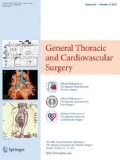Dear Editor,
We read with great interest the article by Fiorelli et al. about the use of Ciaglia Blue Dolphin (CBD) kit (Cook, Medical, Bloomington, USA) for percutaneous dilation tracheostomy (PDT) in the treatment of tracheal stenosis under the tracheotomy tube [1]. We appreciate the innovative approach of this procedure, since tracheal stenosis often requires a surgical repair [1].
Tracheal stenosis has been claimed to be a serious complication of tracheostomy with a low and comparable incidence with PDT techniques and surgical tracheostomy [2]. Tracheal stenosis mainly occurs when the tracheostomy tube is in place for a long period of time, and we know from current literature that 10% of tracheostomized patients have the tracheostomy tube in place at 1-year follow-up [3]. CBD kit (Cook, Medical, Bloomington, USA) has a modified angioplasty balloon to dilate the trachea, this kit is used for 10% of PDT worldwide [4, 5]. In the article by Fiorelli et al., the balloon was inflated with saline solution to 11 atmospheres, and the dilation of the stenosis was repeated 2 or 3 times for 15–30 s each, while the patient was ventilated by a laryngeal mask airway (LMA) with a video-broncoscope inside [1]. This means that the tracheal lumen was completely occluded during the dilation for a period of time ranging from 30 to 90 s, while the video bronchoscope partially occluded the lumen of the LMA through the entire procedure [1]. The presence of the bronchoscope in the LMA, as well as in the endotracheal tube, reduces the diameter available for patients’ ventilation [6] and this is responsible of a decrease of the delivered tidal volume, an increase of airway pressure and of respiratory acidosis [7]. Furthermore, the complete occlusion of the tracheal lumen, even from 30 to 90 s, in critically ill patients with stridor and respiratory distress may be responsible of serious desaturation and life-threating situations. Our concerns are about the previous points. Since the use of CBD kit may be promising as a treatment of tracheal stenosis in critically ill patients, we appreciate a lot if the authors may provide (1) the incidence of the desaturations occurred during the procedure, (2) more details about the airway management and (3) the settings of mechanical ventilation if used. Furthermore, it is not clear to us if the procedure was performed as urgent or elective since the serious condition of the patients.
References
Fiorelli A, Bove M, Noro A, Iuorio A, Santini M, Ferraro F. Dilation of tracheal stenosis below tracheostomy tube with Dolphin percutaneous tracheostomy kit. Gen Thorac Cardiovasc Surg. 2020. https://doi.org/10.1007/s11748-020-01311-8.
Putensen C, Theuerkauf N, Guenther U, et al. Percutaneous and surgical tracheostomy in critically ill adult patients: a meta-analysis. Crit Care. 2014;18:544.
Vargas M, Sutherasan Y, Brunetti I, Micalizzi C, Insorsi A, Ball L, et al. Mortality and long-term quality of life after percutaneous tracheotomy in Intensive Care Unit: a prospective observational study. Minerva Anestesiol. 2018;9:1024–31.
Vargas M, Sutherasan Y, Antonelli M, Brunetti I, Corcione A, Laffey JG, et al. Tracheostomy procedures in the intensive care unit: an international survey. Crit Care. 2015;19:291–301.
Vargas M, Servillo G, Arditi E, et al. Tracheostomy in Intensive Care Unit: a national survey in Italy. Minerva Anestesiol. 2013;79:156–64.
Vargas M, Servillo G, Tessitore G, Aloj F, Brunetti I, Arditi E, et al. Double lumen endotracheal tube for percutaneous tracheostomy. Respir Care. 2014;59:1652–9.
Vargas M, Servillo G, Tessitore G, Aloj F, Brunetti I, Arditi E, et al. Percutaneous dilatational tracheostomy with a double-lumen endotracheal tube. A comparison of feasibility, gas exchange, and airway pressures. Chest. 2015;147:1267–74.
Author information
Authors and Affiliations
Corresponding author
Additional information
Publisher's Note
Springer Nature remains neutral with regard to jurisdictional claims in published maps and institutional affiliations.
Rights and permissions
About this article
Cite this article
Vargas, M., Marra, A., Buonano, P. et al. A promising treatment of tracheal stenosis in critically ill patients. Gen Thorac Cardiovasc Surg 68, 1605 (2020). https://doi.org/10.1007/s11748-020-01330-5
Received:
Accepted:
Published:
Issue Date:
DOI: https://doi.org/10.1007/s11748-020-01330-5

